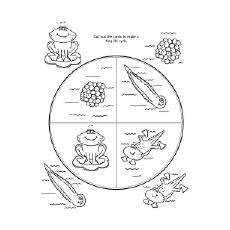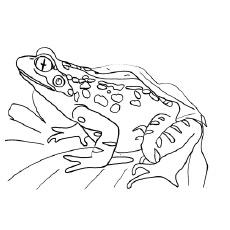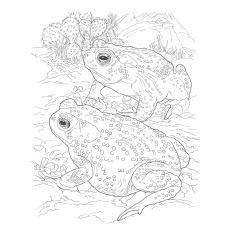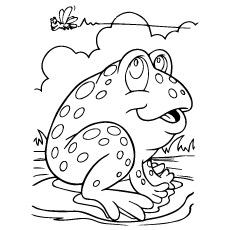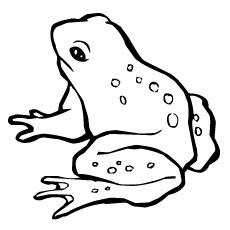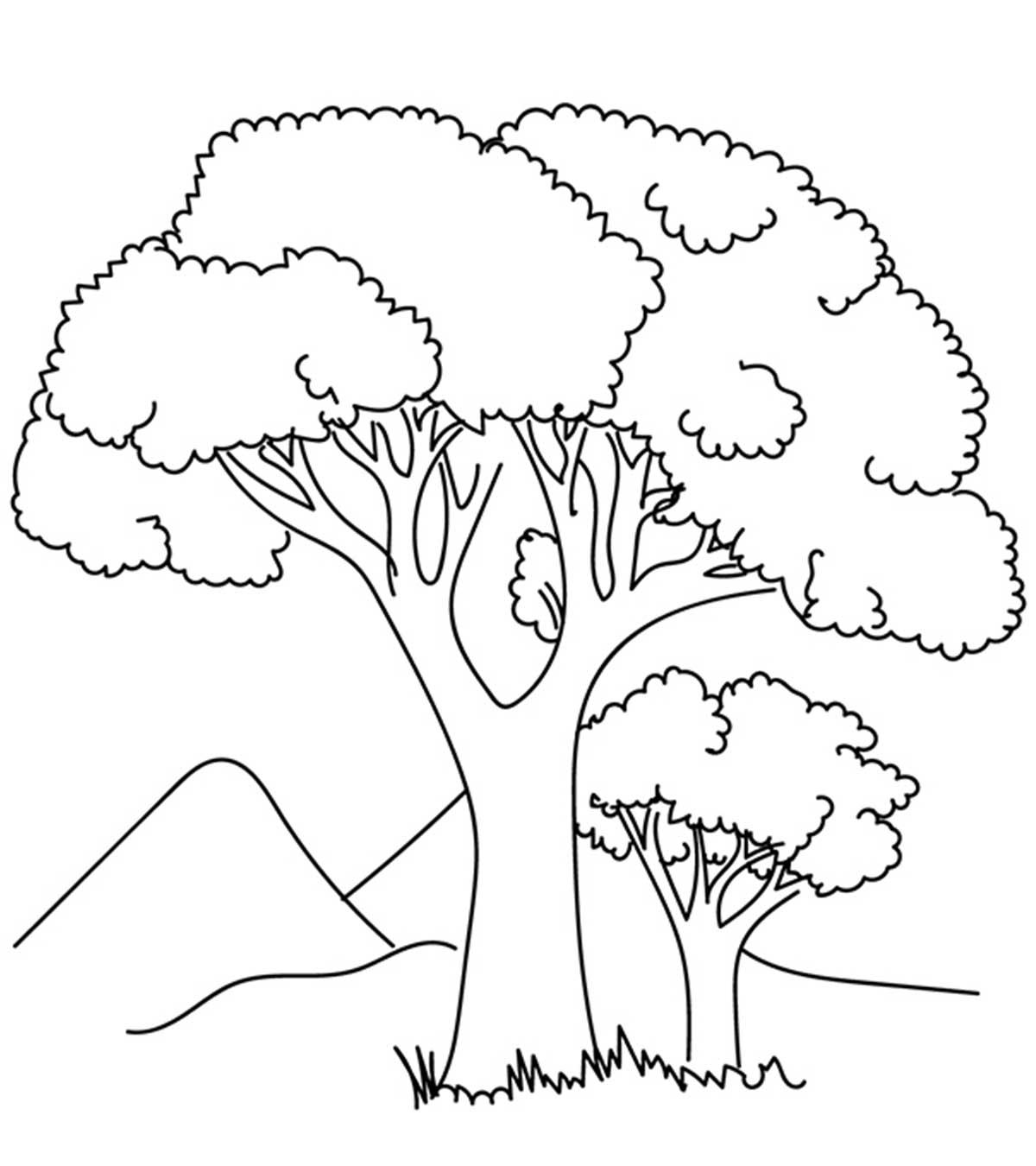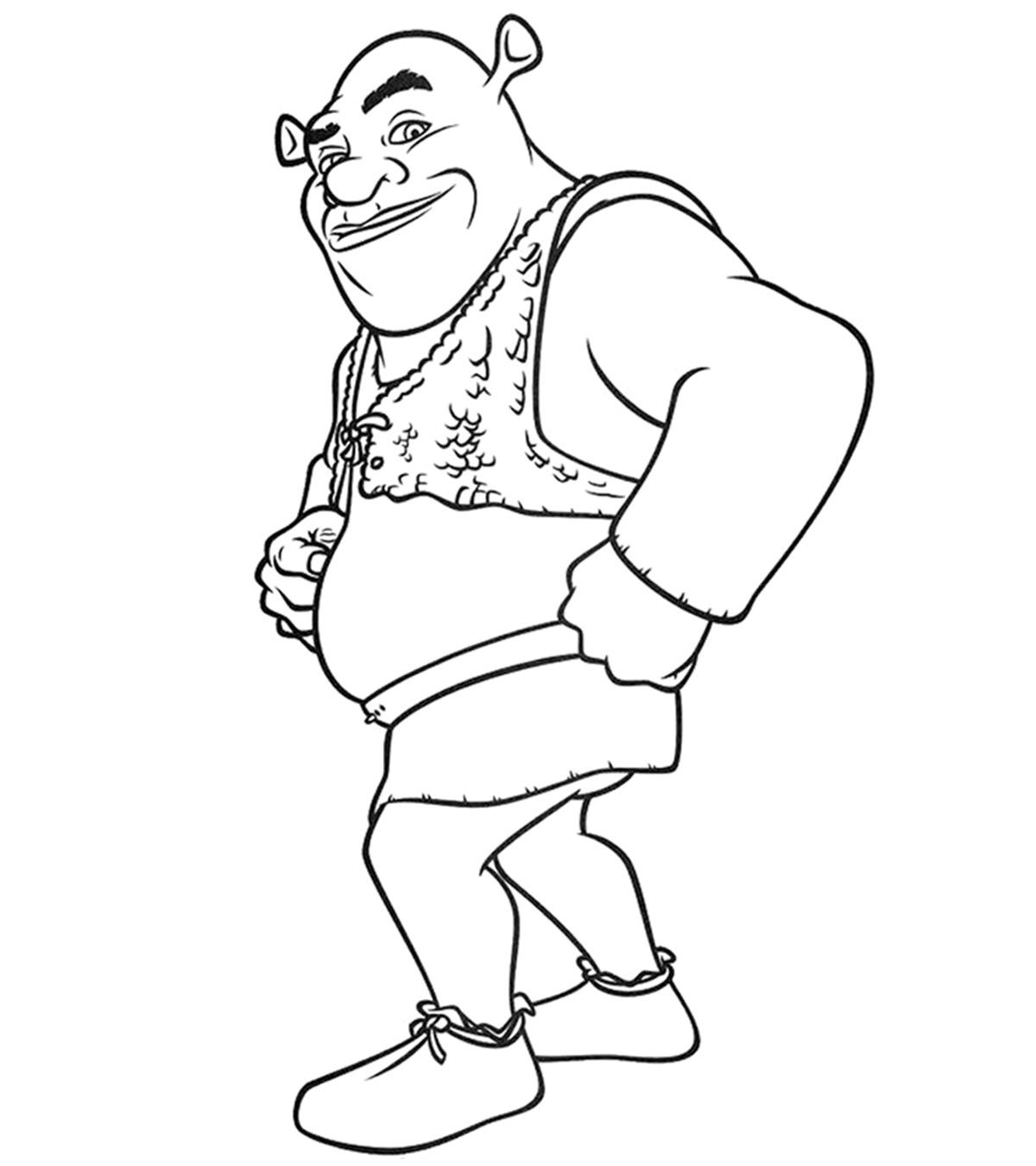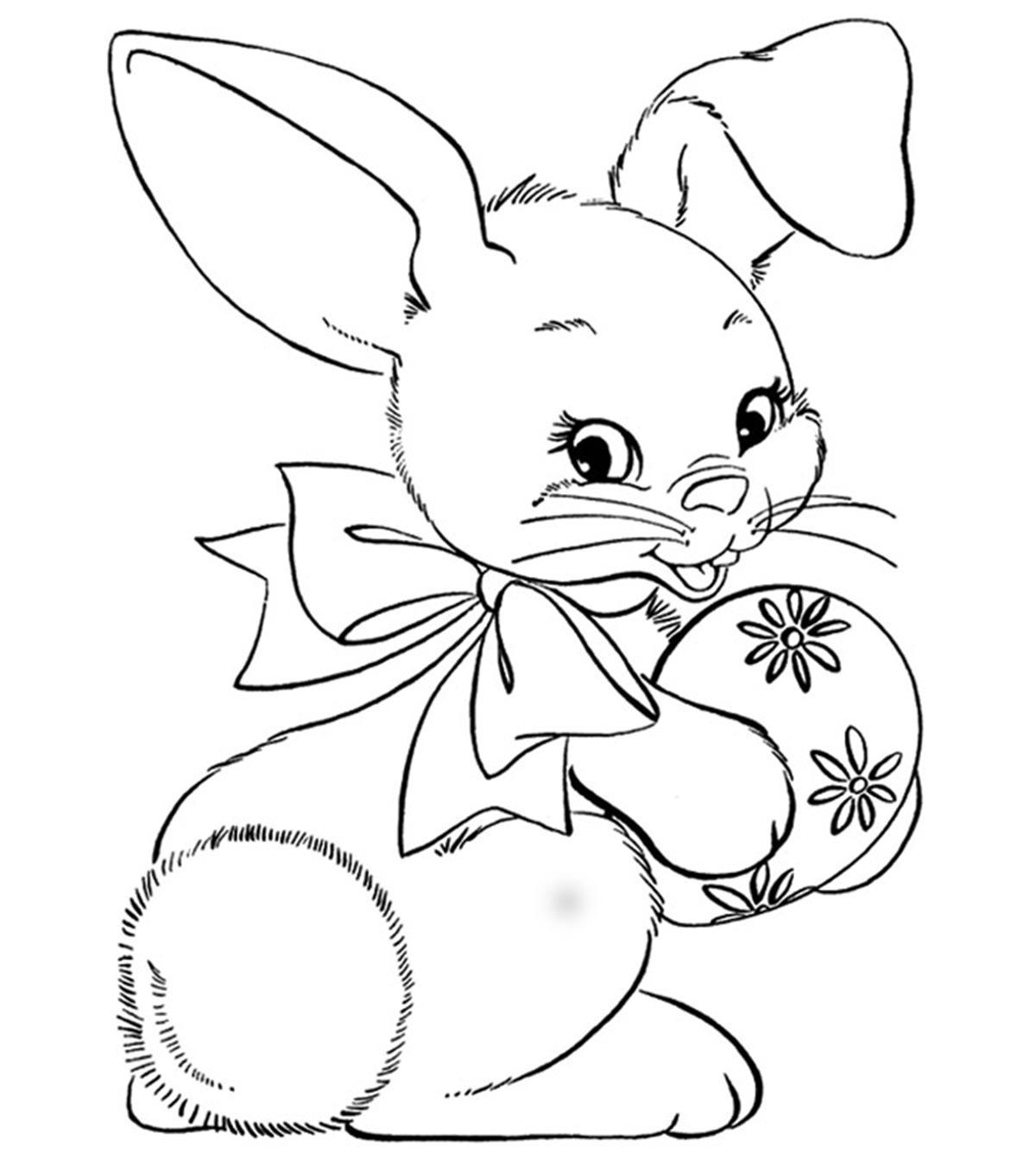Are you looking for some frog coloring pages to teach your little one more about these amphibians? Are you looking for ways to teach him about the importance of the freshwater ecosystem through coloring pages? Whatever your reason, if you’re looking for some high-quality frog coloring sheets: then this is the right place for you!
The frog is a fascinating reptile with unique characteristics. These tiny amphibians with plump bodies and protruding eyes inhabit the dry land and fresh water. Frogs are rather popular in kid’s stories and rhymes. These tailless animals have also been featured in several animated films and cartoons. Their humorous roles in the series have made them a favorite coloring page subject among kids. Children love coloring frogs in multiple colors. So, here are 25 delightful frog coloring pages for your little ones. Some are simple coloring pages for preschoolers while some are complex pictures for older kids. Check out all of them below!
Top 25 Free Printable Frog Coloring Pages For Kids
1. Frog
Here’s an introductory coloring page for frogs. There are around 48000 different species of frogs found all over the world, beautifully painted by Mother Nature. You’ll see these animals in every part of the world, except Antarctica. Scientists have also found frog fossils dating back to 140 million years. Ponds, lakes, and marshes are their favorite spots. A unique feature about frogs is that they breathe and drink through their skin. When frogs feel too hot, they get into the water to cool off, and when they feel cold, they bask in the sunlight to warm them up.
2. Tree Frog
Here’s a tree frog coloring page. As the name implies, a tree frog resides only in trees. And they are triumphant, as you can see on the coloring page. These frogs are native to South and Central America. Tree frogs are great jumpers. They love hanging and scaling around, just like monkeys. These frogs are also rather intelligent. They spend their time curling up by hiding their flanks and then surprise the predators by unwinding. Tree frogs use the substances excreted from the ear glands to coat themselves. This coating makes them waterproof. These frogs come in bright colors. So tell your little one to break out his electric blue and hot pink crayons for this happy creature.
3. Toad
Here’s a coloring image of a toad. A toad is a close relative of the frog. These animals are typically brown, but black, pink, and yellow toads are also common. Toads are nocturnal animals. They spend much of their daytime resting and night hunting. Do you know the difference between a frog and a toad? Frogs have a narrow body with smooth and moist skin while toads have a broad body with rough and scaly skin. Can you get warts from holding a toad? No, that’s a myth, but you can die from holding a toad if it’s a poisonous toad. The toxins secreted by these amphibians are so toxic that it can kill an adult human.
4. Tadpole
This coloring page features a tadpole, the larval stage in the life cycle of a frog. Tadpoles are aquatic in nature. They hop into ponds the moment they develop from an egg. Tadpoles respire through their internal gills. They do not grow legs or arms until they become proper adults. But they do have a long, flattened tail that helps them to swim. Tadpoles face a very tough time in the pond. They have to make their way past an army of predators before developing into froglets. Kids will enjoy the mini science class while coloring this tiny tadpole.
5. Cute Frog
Here’s a beautifully animated frog coloring sheet. Give this coloring page to your nature lover and see her delightfully filling the diagram with her favorite colors. Share this fun fact with your little one as she paints the image. Both frogs and toads are omnivores. Small to medium-sized frogs like to feed on insects like flies, moths, mosquitoes, and dragonflies. Larger frogs eat large insects like worms and grasshoppers. Some frogs eat mice, baby turtles, small snakes, and even small frogs. And some even starve themselves before eating a dead animal or insect. These frogs like their food fresh. These amphibians have a vast appetite; we must say.
6. Frog Lifecycle
Explore the frog’s life cycle with your aspiring biologist with this coloring page. Every animal goes through different stages of development throughout its life, and the same is the case with frogs. The frog life cycle in the coloring image shows a cluster of frog eggs or egg masses. The tadpoles hatch from these eggs and thrive in the pond and other freshwater habitats. The tadpoles then turn into froglets and then they become frogs. Kids can also cut out the cards for doing school projects. But first, give them some beautiful colors. Make sure he writes the names of each stage of the frog’s life cycle on this informative coloring page.
7. Frog Basking In The Sun
This coloring page of a frog looks rather delightful. It features a happy frog basking in the sun. But it may help to know that frogs cannot stay in the sun for long. Staying too long in the sun can dry their skin, eventually leading to death. So it is essential for them to live in a damp place. The coloring page will look even more stunning if your kid draws a few birds flying near the mighty sun.
8. Mama And Baby Frog
Ribbit! Mama and Kid Frog need some color. Can your tot give them some bright colors? Preschoolers are sure to love filling colors in this adorable pair. An astonishing fact about frogs is that they are excellent indicators of the quality of the environment they thrive. They even provide medicines, including compounds useful for treating medical conditions like cancer, depression, seizures, and strokes.
9. Leaping Frog
This coloring page shows a frog making a splash while leaping out of the water. Frogs are great leapers. They can jump 20 times their body length. But do you know how? Frogs have powerful muscles in their back legs that help them jump over large distances while pushing from the surface. The longer the frog’s back legs are, the further it can leap. Hopping is also an excellent way to escape the danger. Frogs also hop back to their home in water to lay eggs. The coloring page is not only lacking colors but is also lacking some details. Tell your kid to make a forest backdrop to go with the picture. This coloring page will also make a great addition to Leap Day activities.
10. American Toad
American toads are native to the Nearctic region but are found throughout North America. These toads have an amazing ability to adapt to their surroundings, but there must be semi-permanent water for them to thrive. They also need patches of vegetation that they can use for their hunting grounds. American toads have stout bodies, short legs, and very thick skin with noticeable warts. These warts can be anything between red and yellow. The color of the toads ranges from brown to yellow to black. Just like other toads, even American Toad’s warts contain glands that can produce a poisonous milky fluid. The milk fluids provide excellent protection from predators.
11. Gabi
Gabi is a character in the upcoming Rio 2 movie. This cute, pink frog is the secondary antagonist of the film. Gabi is a poison dart frog who is head over heels in love with Nigel. She claims that she is not villainous but is slightly misunderstood. But in reality, she is as vicious and as ruthless as her beloved Nigel. Despite her small stature, Gabi hatches some evil plans for Nigel and even assists him while executing them. She even attempts to kill Blu by poisoning him while he is asleep. Gabi is a tiny, bright pink frog with shiny skin and black-purple spots.
12. Red-Eyed Tree Frog
The frog coloring page shows a red-eyed tree frog taking a friendly break on a lily pad. The red eyed frog gets its name from its huge red eyes that it use to shoo the predators away. These frogs are native to Central America, Southern Mexico, and northern South America. You’ll find these frogs inhabiting the areas near rivers, streams, and ponds. These frogs are very tiny, with male red-eyed tree frogs growing up to 2 cm and females growing up to 3 to 4 cm. The Australian red tree frog can also prevent the spreading of HIV infection, the primary cause of AIDS.
13. Poison Dart Frog
Here’s a coloring image of a poison dart frog. The poison dart frogs reside in their rainforest habitats in South and Central America. You’ll find them hanging around in trees, logs, and forest floors. These frogs got their name from the fact that the hunters would use the toxic secretion from their bodies to cover the tip of the darts. Poison dart frogs are very tiny, barely ½ to 2 inches long, which makes them very hard to spot. These frogs prey mainly on invertebrates like ants as they help build strong poisons in the body. Sadly, poison dart frog numbers are reducing drastically because of ranching and cutting down the rainforests for farming.
14. Glass Frog
What is this glass frog doing on the lily pad? He must be searching for his prey. The glass frogs are native to the basins of the Amazon forest. These are some of the most bizarre-looking frogs. They have a transparent skin chest and tummy, which allows people to see their heart, intestines, and liver clearly. Scientists say that their transparent skin serves as a protection for them. The lights reflect off the leaves to shine through the frog, making it harder for the predators to spot them. Glass frogs prefer living in the trees of mountainous and humid areas. Just imagine how it would be looking through the frog’s translucent skin and seeing its heart beating.
15. Sonoran Desert Toad
At 8 inches, the Sonoran Desert Toad is one of the largest toads in South America. As the name suggests, you’ll find these toads in the Sonoran Deserts. But they also occur in the pink oak woodlands and grasslands of major South American forests. These frogs have a typical olive green to brown skin and elongated glands on both sides of the head. Sonoran desert toads release extremely potent toxins from their glands. They intoxicate the animals who harass them through their mouth, nose, or eyes. These toads eat a variety of insects throughout their lives. Adult Sonoran desert toads eat beetles while giant desert toads eat small vertebrates, including other toads.
16. Goliath Frog
The frog you see here is the Goliath frog, the largest and heaviest frog in the world. It may not seem huge on the coloring page, but in reality, it can grow up to 33 centimeters in length and can weigh up to three kilograms. Even the giant African bullfrog is just half the size of the Goliath frog. The Goliath frog is endemic to West Africa. It can eat small snakes, crabs, insects, and even other frogs. It has massive legs that allow it to jump great distances, up to 10 feet. The Goliath frogs cannot make any sound because of the lack of a vocal sac. Unfortunately, just like many other species of frogs, even the Goliath frog is vulnerable to many human activities like pet trade, deforestation, and hunting. The Goliath frog now falls under the endangered species category.
17. Princess And The Frog
If Princess Tiana kisses this frog, will he turn back into Prince Naveen? Well, we’re not very sure about that, but giving it some colors will bring this frog to life! Prince Naveen arrives in town to deal with shady down. But things take an entirely different turn when he meets Princess Tiana. When your kid is done with coloring, ask her how the story ends and see what he answers. Or tell your child to read the story first and then color the picture.
18. Frog Prince
Here’s a detailed coloring page of the Frog prince from a fairy tale of the same name. The belief that frogs can change into people is widespread in many cultures. Even the Disney film “The Princess and the Frog” is an adaptation of this fairy tale. In the story, a bratty princess befriends the Frog Prince, who magically transforms into a handsome prince. Unlike the Disney film, in the original story, the frog’s spell breaks when the princess throws it against the wall in disgust. Let your kid’s imagination take flight as he brightens up this scene. If you can get your hand on the original Fable, read out the story to your kid.
19. Lazy Frog
Mr. Frog is feeling too lazy to catch the bumblebee with his sticky tongue. But what will he eat if he lets go of all his prey? We believe that giving him some colors will get him back to life. Frogs have a long and sticky tongue that they roll out to snatch insects and bugs from the air. The frog then snaps back its tongue and throws the food down the throat. But many species of frogs do not even have tongues. Can your kid guess the name of that frog? Your little one will have a great time practicing coloring inside the lines.
20. Horned Pacman Frog
Here’s a simple coloring image of a horned Pacman frog. A horned Pacman is a bright reddish-orange frog with big horns and mouth. It’s native to South Africa and is mainly used for experiments. These frogs like to bury themselves in leaf litter or loose soil. The horned Pacman frog has cannibalistic tendencies. These frogs also mistake the owner’s fingers for food. So if you are planning to keep this bright frog as your pet, then be very careful. This coloring page is perfect for children who are just learning to hold crayons and pencils. It will develop his fine motor skills too.
21. Kermit
The cute frog you see here is Kermit, one of the most famous Muppets. Kermit is the protagonist of “The Muppets” franchise. Kermit grew up with hundreds of his siblings in the swamps. He is a slender green frog with white eyes. He is a cheerful, optimistic, loving, caring, humorous, and wise frog. The only problem with Kermit is that he gets frustrated easily and loses his calm. Fun fact- Kermit was initially a lizard-like character and made any appearances as a lizard before the producers established his status as a frog. They even added a collar to make him appear like a frog and conceal the seam between his body and head.
22. Frankie
The smart frog you see here is Frankie, a minor character from Disney’s “Meet the Robinsons.” Frankie is a small and slender green frog that always appears in a tuxedo. It is a cool, funny andeasygoingg frog who loves being upbeat. Music is his passion. He spends most of the time performing with jazz orchestras with his gang. Frankie even appeared in the movie singing with his jazz ensemble held by Franny Robinson. Frankie is also very kind and helpful and goes out of his way to help his friends. He also saved the Robinsons from the attack of T-Rex.
23. Surinam Frog
The frog you see peeking through the grasses is the Surinam frog. Just like many other species of frogs, even the Surinam frog belongs to the Amazon rainforest. It’s a pretty large frog and can grow up to twenty centimeters. The Surinam frog is a mud-brown frog with huge eyes and an extremely flat body. Its unique appearance makes a good camouflage for them. A unique feature of this frog is that it has no teeth or tongue. So instead of croaking like normal frogs, these toads strike two throat bones together to produce a clicking noise. Surinam frogs like to spend most of their time in the water. And while hunting, these frogs wait for the prey to come. Do you know what Surinam frog likes eating the most? Surinam frogs love to feed on mice, lizards, and large insects.
24. Harlequin Toad
This frog coloring sheet features one of the deadliest frogs in the world, the harlequin toad. The harlequin frog emits an extremely potent, toxic poison that is 100 times stronger than potassium cyanide. The frog changes its colors from black to yellow to purple to warn the predators to steer clear of them. The only creature that poses a threat to this frog is a parasitic fly. These flies lay their eggs on the frog’s eggs, which slowly enter their body. The eggs then devour the internal organs of the frogs, eventually killing it. Its number has also decreased rapidly because of the spread of fungus and changes in climate.
25. Darwin’s Frog
Here’s a coloring image of a Darwin’s frog. This frog is named after Charles Darwin, who discovered it while he was on his world tour. This frog is a resident of the cool streams of Argentina and Chile. These frogs are rather aggressive and do not hesitate before attacking animals larger than themselves. Do you know what makes this frog so unusual? It’s the way it takes care of the tadpoles. Mama frog lays the eggs, and papa frog guards the eggs for about 2 to 3 weeks. Papa frog then carries the surviving tadpoles in his vocal pouch. Yes, you read that right! It carries the tadpoles in its throat. The tadpoles develop in the chin skin. These babies hop out and swim away when they turn into tiny froglets.
Your kid will never feel bored coloring these cute frog coloring pages. They are free to be as creative as they want to produce the perfect color combinations.
Community Experiences
Join the conversation and become a part of our nurturing community! Share your stories, experiences, and insights to connect with fellow parents.






